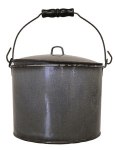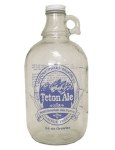- Old Fashion Growler
- Original Otto Brothers Growler
- A German Siphon
While reading an article about the Grand Tetons Brewing Company (formerly Otto Brothers’), I was reminded of a story that my grandmother once told me. As a child, she was sent out to the local pub by her father to fetch a fresh haul of beer in thin-walled metal pail. Similarly, Charlie Otto, co-founder of Otto Brother’s Brewing Company (now Grand Teton Brewing Company in Victor, Idaho), was told the same story by his father. When opening the brewery in 1988, the Otto brothers recalled the tale of “to-go” beer and decided the modern-day brewery needed a “pail” equivalent – a 64 ounce glass jug called a “Growler”. In 1989, the Otto brothers purchased a palette of glass cider jugs, silk screened logos on them, and were the first Americans to sell these refillable novelties to their customers. Today, almost 24 years later, the modern growler is often seen as the savior of the brewpub, simply because single bulk vessels can boost profits margins higher than costly bottling operations.
When Charlie Otto’s father first mentioned rushing home the “Growler”, Charlie replied, “What the hell is a Growler?” It has been speculated that the the name “Growler” originated in the late 1800’s. During this time, much of beer produced was packaged in kegs with only limited volumes bottled. Bottling operations were crude and unreliable, and during transport beer quickly spoiled. The freshest beer of the day was generally served straight from the tap. “To-go” beer in many cities across America was transported in small metal pails with lids. On the trip home, the sloshing of beer accelerated the release of carbon dioxide, and the gas gargled or “growled” as it escaped from underneath the lid; thus, giving the name, “Growler”. Pre-WWII, it was not uncommon to see children carrying and paying for pails of beer at the local pub. In fact, city kids often transported buckets of draft beer to workers at lunchtime and grabbed to-go pails on their way home from school for dinner consumption. This practice was called “rushing the growler.”
About the same time Americans started to us pails to transport beer, the Germans were well ahead of the curve by using a glass or porcelain jug with a clasp-sealed lid, called a “Siphon”. This innovative releasable lid kept the beer inside of the siphon fresh and carbonated much longer than the American pail. Like the old growler pail, the German siphons eventually disappeared, as bottling and brewing technologies increased beers longevity. By the early 1900’s, both countries started to see a decline in growler or siphon refills and more trips to the local market for bottled beer.
In 1975, Erich Wassmann, a German antique dealer, reminisced the cheerful days of to-go beer after purchasing a vintage siphon at auction. Later that year, Wassmann saw an opportunity to reintroduce siphons to small German breweries and brewpubs as a means to transport local village brews. Today, the Industrieglas Wassmann GmbH & Co is a third generation company that sell siphons and other glassware to breweries big and small around the world.
The modern growler or siphon that is filled at a special growler station has a shelf life of at least 7 to 10 days (a growler station is beer tap with a tube specifically sized to reach the bottom of the vessel, reducing carbon dioxide loss during filling). Once opened, the beer may stay carbonated for up to 3 days; however, it is best to drink the contents immediately.



Leave a comment